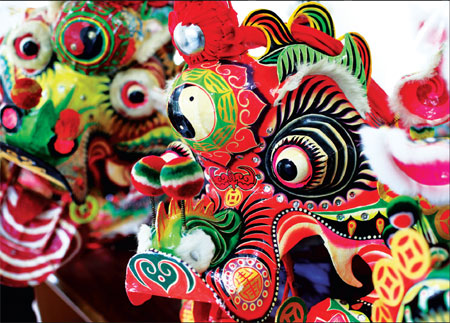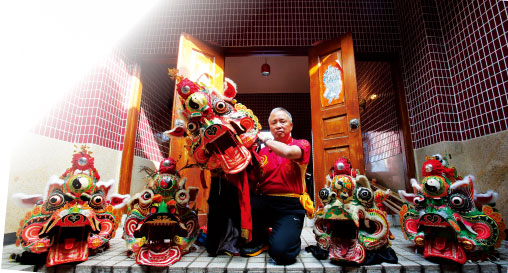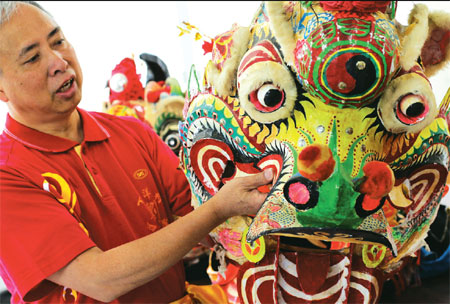Unicorn rises again
Updated: 2015-02-16 07:30
By Ming Yeung(HK Edition)
|
|||||||||
A ritual dance involving the mythical animal to mark Chinese New Year would be de rigueur in Hakka villages until the 1980s. Today it's left to a few diehard types to keep the tradition alive. Ming Yeung reports.
Tom Lau Yuk-tong stood squarely, feet on the ground and slowly lifted the head of one of five qilin, Chinese unicorns, arranged on a table.
The percussion instruments - a large gong, a pair of cymbals and a small drum raised a deafening roar - ceaseless, unrelenting, driving the rapid gyrations of the mythical beasts at play, leaping high and kicking their hooves. The afternoon sunlight danced on the gold-sequined scales.
The motion was swift. The head of the qilin moved in a circular direction, left to right, respecting the Chinese tradition that places seniors to the left and juniors to the right, said Lau.
On the third day of the first month of the Lunar New Year, Tom Lau and his fellow villagers will go out to meet unicorn dancers from other villages in front of Tin Hau Temple in Sai Kung to deliver blessings to the people.
The sacred chimera-like creature requires a number of practitioners to perform the "eye opening" ritual to give birth to one qilin.
The ritual is carried out in the hills at midnight on an auspicious date selected by a shifu or teacher. There comes a moment of complete stillness, when all creatures are at rest and the spirits of evil emerge. Then the practitioner will draw the eyes of the qilin, endowing it with life, so the people may worship the creature in the village ancestral hall, and during the ritual dance, receive its blessings.
The villagers, Hakka people, whose ancestors migrated down from Shanxi province, believe the qilin to be auspicious, bringing good fortune and possessing the power to ward off evil. The rite has been performed for more than 280 years in the village.
The divine beast is one of the four most important mythological animals of Chinese legend. Along with the dragon, the phoenix and the tortoise, the qilin is considered a creature of great benevolence. Qilin also is believed to be mild-mannered, even, "gentlemanly" and refined, able to walk on water without causing ripples and walk on grass without crushing it.
The horn, in the shape of a gourd, symbolizes "seizing wealth". The Eight Trigrams symbolizes the principles of reality, and a small round mirror is said to reflect all evil, even those that come with human features.
Qilin often presides at the plucking of the greens, a ceremony in which dancers grasp heads of lettuce stuffed with red "lucky money" packets hung high on the door during celebratory occasions. In Cantonese, lettuce is a homophone for the expression "getting wealthy". The higher the lettuce is hung, the greater the good fortune.
The frame is made from whangee, a genus of bamboo. High-quality papers are pasted onto the frame to shape the skin. Qilin are recognizable from their beautiful form, standing tall, with a tail up to four meters long, made of fabric in five colors, to represent the elements.
The colorful beast is decorated with paintings of peony, peach blossom, chrysanthemum, butterflies, etc., on its body. The drawings vary depending on the preferences of the paper-crafting master, but the dominant colors are always green and red to match the festive mood, said Lau.
It takes three months to build these mythical creatures. Only a few paper-crafting masters remain in Hong Kong. Most qilin are made in Guangzhou at a cost of HK$5,000 these days. Still they are built to last up to 20 years. Lau gestured to show a yellowish qilin, weighing about 3 catty (about 1.5 kilograms). Only faded traces of the original colors remained. Another newly made one sits adjacent, wrapped in transparent plastic. Lau explained that qilin can be used only after the opening of the eyes.
Fading out
The Hang Hau Hakka Unicorn Dance has been successfully inscribed onto the fourth national list of intangible cultural heritage, as announced by the State Council in 2014. But two decades ago the performing art was in decline and appeared to be headed for extinction.
Lau Kam-tong, village representative of Ha Yeung Village in Clear Water Bay, said that during the 1980s, when many indigenous people moved to Europe, the unicorn dance lost its importance. Many villages stopped practicing it.
"The first few years I organized unicorn dance performance during the Chinese New Year, only three troupes remained among 18 large villages in Sai Kung district," Lau said.
When Lau was a boy, most kids in the village were taught kungfu and the unicorn dance for self-protection. "When we were 7 and 8 years old, we were taught kungfu to protect the village from pirates," Lau said.
Returning to Hong Kong in 2003 from the UK, Lau felt that he had to revitalize this tradition after joining the rural committee. Since 2004 onwards, Lau has organized unicorn dance performance. Now the number of troupes has expanded to 10. They have been invited to perform in special occasions like the turnover celebration and the Olympic Games.
Lau is hoping the government would at least sponsor whichever village is willing to carry on this practice and inject fresh blood into the dying stream of art.
Contact the writer at mingyeung@chinadailyhk.com
|
'The Qilin legend' Qilin is one of the Four Benevolent Animals in Chinese mythology. It's also an intangible part of China's cultural heritage. As the Chinese New Year is right around the corner, chinadailyasia.com brings you the story behind it. |
|
Qilin can be used only after the opening of the eyes ritual. edmond tang / China Daily |
|
Hakka people believe the unicorn brings good luck and wards off evil. |
|
Tom Lau is one of the last doyens of the unicorn dance, trying to inspire more young people to join forces with him. |
(HK Edition 02/16/2015 page8)



